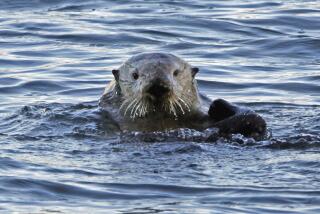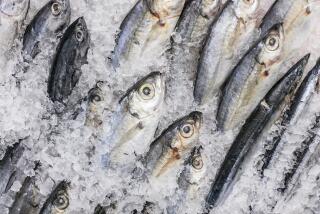Oyster Men Who Sail in Skipjacks Vow to Keep Fighting : Chesapeake Bay Slowly Dying From Pollution
TILGHMAN ISLAND, Md. — On the squally, unpredictable waters of the Chesapeake Bay, the captain of a skipjack rules with no back talk.
Anywhere on Maryland’s Eastern Shore--which sometimes seems willfully frozen in an era 100 years behind the rest of the country--you can name such a man and people listen with respect. Aboard ship, his crew snaps to without question.
Some say those who live by dredging oysters from the dwindling beds of the pollution-troubled bay are a dying breed, but the men who command the last commercial fishing fleet under sail in the United States swear that they will not quit as long as there are bivalves to be torn from the bottom.
The rigors of the Chesapeake seem to lock a man to a life on the water. In the off-months, there are wild skipjack races where “the only rule is to win” and excursions to Annapolis for stubborn fights with lawmakers and polluters over how to save the bay.
A Worthy Skipjack
Russell Dize, 45--a stocky, ruddy, jocular, fourth-generation waterman--owns and commands the 85-year-old Kathryn, a shallow-draft vessel 75 feet from bowsprit to stern davits, with a 67-foot raked mast, a 50-foot boom and a massive mainsail and jib. It is one of the fastest skipjacks in Maryland waters.
“Nine out of 10 of the skippers on the bay would want this boat,” said Dize of his beautifully kept skipjack. “She’s the best boat on the bay.”
As Dize maneuvers the Kathryn through the strong tides and constantly changing winter winds of the Choptank River estuary off the bay, he waves to a fellow skipper who waves back with his bandaged right hand encased in a plastic bag.
Lost Finger
“That’s Robbie Wilson,” said Dize. “He cut off his right forefinger on a circular saw last week. He took the finger to the hospital where they told him they might be able to reattach it, but because the knuckle was destroyed, it would stick out at an angle.
“He figured it would get in the way of his work and told the doctors not to bother. They sewed up the wound and he didn’t miss a day (of oyster dredging). He’s a good skipper and he’s tough.”
Tough is a common word among Eastern Shore watermen. Bill Roulette, a waterman all his life and an official of the Izaak Walton League, a leader in the fight to save the bay from the toxic encroachment of civilization, said: “It’s a tough life--you play tough.”
Dize and his six-man crew work 12 to 14 back-breaking hours a day hauling oysters from the bottom. Dize carefully steers the Kathryn up and down the beds, all the while barking orders to his inexperienced crewmen, most of them in their teens, each with arms as thick as a young woman’s thigh.
Dragging the Bottom
Dredges made of iron rods, cold chisel teeth and stiff rope nets are dumped from the port and starboard sides of the boat, dragged along the bottom for a few minutes and yanked up by a cranky power winch that jolts the boat from side to side.
Each dredge hauls up about five bushels of shells and debris that are dumped on the deck. The crew stoops over the pile and and culls the oysters in a practiced frenzy.
A good “lift” will get 50 to 60 oysters, a poor one maybe only 10 or 12. The crew has to work lightning fast because the dredge is usually dumped back overboard while they are still culling.
They also must have an unerring eye on the catch--oysters have to be a minimum of three inches long, and violations can result in stiff fines.
Limit Rarely Reached
In the lean months, skipjacks rarely reach their daily limit of 150 bushels and are happy to come back to the shuck houses with 100. In the more bountiful early months of the November-to-March season, a good captain and crew can “limit out” nearly every good day.
In other parts of the country, oysters are taken by poser boats, but in the Maryland waters of the Chesapeake and its river tributaries, state conservation laws allow only the antiquated and graceful skipjacks--the fleet now numbers only about 30--to dredge the oyster beds.
Although the bay used to fulfill most of the nation’s oyster demand, the emergence of power boats and the development of the Gulf and West Coast beds reduced the ailing Chesapeake’s share to only 20% to 30% of the market.
The 1985-86 Maryland season is expected to produce about 1.2 million oysters, compared to 15 million in the bay’s heyday, but Dize says propitious weather conditions last summer, with little rain to reduce the salinity of the water, spurred oyster breeding. He predicts a bumper crop in two years when the new generation of oysters has matured.
4,000-Mile Shoreline
Flanked by the states of Maryland and Virginia, the bay runs 200 miles from the mouth of the Susquehanna River to the Atlantic. It is North America’s largest estuary and varies in width from four miles at Annapolis to 30 miles at the mouth of the Potomac. Its wandering shoreline, including the marshy inlets of the Eastern Shore on the Delmarva Peninsula, is estimated at about 4,000 miles--more than the width of the United States.
The bay has been victimized for decades by man, nature and chemicals and its bounty of oysters and other seafood--including the famous Chesapeake blue crab--that supplies much of the nation has suffered heavy losses.
Eastern Shore watermen have no dreams of returning the bay to the pristine state of the past, but they are determined that it survive and produce its sea life in abundance.
“We want to get the bay back to where it was in 1955,” Dize said, a time when eelgrass, a lush green water plant necessary to oxygenate the water, still abounded and pollution had not got out of hand.
Bay Worsened
In 1972 when Hurricane Agnes ravaged the East, the steady decline of the bay worsened dramatically.
When a watermen spits out the word “Agnes” or “ ‘72” everyone on the Eastern Shore knows he is talking about the disaster that threatened the livelihoods and life styles of thousands.
Agnes flooded all the Eastern Seaboard rivers and streams that feed the Chesapeake, causing $2.1 billion in damage and 122 deaths.
The mighty, 444-mile Susquehanna River that carves a channel through the center of the bay was one of the worst hit. Its raging waters carried distant silt, debris and pollution into the bay.
‘Houses Floating in Bay’
“That flood brought everything from Pennsylvania and New York,” said Dize, who is vice president of the Maryland Watermen’s Assn. “We had tires, trees, even houses floating around here.”
The natural disaster, which virtually eliminated what eelgrass remained, took the bay into a nose-dive.
Hard work by conservationists has helped arrest the poisoning of the waters, but the Chesapeake is so beset by pollution from different sources that a strategy for cleaning presents a conundrum.
Sewage, chlorine used to treat sewage, phosphates, acid rain and simple junk all mix into a nearly toxic brew. Bill Roulette, one of 10 1985 winners of the Chesapeake Bay Conservation Award sponsored by the Izaak Walton League and the Dupont Co., grapples with attacking all the problems simultaneously.
Applying the Pressure
This means putting pressure on local and federal politicians, polluting corporations and towns, agencies that are supposed to enforce existing laws and just plain people who toss beer cans and filled garbage sacks into the bay and its rivers.
“We can’t just turn to the federal government,” Roulette said, “especially with the concern about the deficit.”
He said the biggest thorn is making people on the rivers that feed the Chesapeake understand that what they do upstream has a vital impact on the bay.
Add to that the frustration of making people obey laws that environmentalists fought hard to get on the books.
3,300 Violations
Dize says there is one plant in Baltimore County, Md., that has been cited for 3,300 violations of environmental laws “but has never spent a day in court.”
Although Dize, who quit school after falling in love with the bay, is optimistic about the future, he says he won’t let his son and daughter near the water. She is a sophomore in Old Dominion College and he is a freshman in high school.
“I don’t want my son on the water,” says Dize with a chuckle. “I want him to be a dentist or a CPA, something like that.”
More to Read
Sign up for The Wild
We’ll help you find the best places to hike, bike and run, as well as the perfect silent spots for meditation and yoga.
You may occasionally receive promotional content from the Los Angeles Times.






